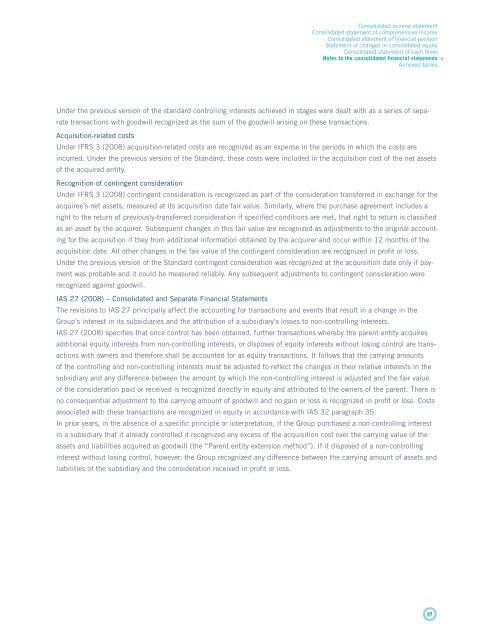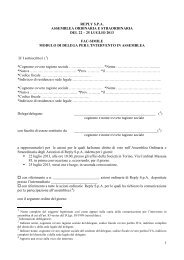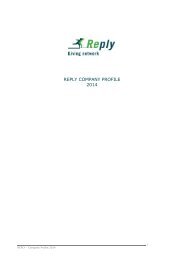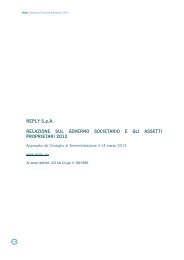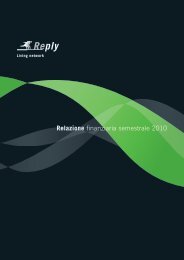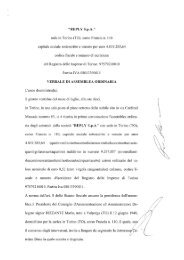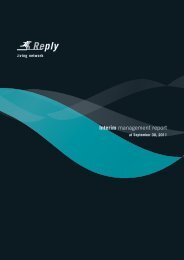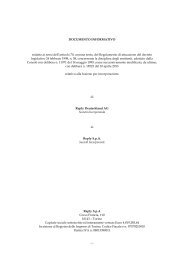Reply SpA
Reply SpA
Reply SpA
You also want an ePaper? Increase the reach of your titles
YUMPU automatically turns print PDFs into web optimized ePapers that Google loves.
Consolidated income statement<br />
Consolidated statement of comprehensive income<br />
Consolidated statement of financial position<br />
Statement of changes in consolidated equity<br />
Consolidated statement of cash flows<br />
Notes to the consolidated financial statements <br />
Annexed tables<br />
Under the previous version of the standard controlling interests achieved in stages were dealt with as a series of separate<br />
transactions with goodwill recognized as the sum of the goodwill arising on these transactions.<br />
Acquisition-related costs<br />
Under IFRS 3 (2008) acquisition-related costs are recognized as an expense in the periods in which the costs are<br />
incurred. Under the previous version of the Standard, these costs were included in the acquisition cost of the net assets<br />
of the acquired entity.<br />
Recognition of contingent consideration<br />
Under IFRS 3 (2008) contingent consideration is recognized as part of the consideration transferred in exchange for the<br />
acquiree’s net assets, measured at its acquisition date fair value. Similarly, where the purchase agreement includes a<br />
right to the return of previously-transferred consideration if specified conditions are met, that right to return is classified<br />
as an asset by the acquirer. Subsequent changes in this fair value are recognized as adjustments to the original accounting<br />
for the acquisition if they from additional information obtained by the acquirer and occur within 12 months of the<br />
acquisition date. All other changes in the fair value of the contingent consideration are recognized in profit or loss.<br />
Under the previous version of the Standard contingent consideration was recognized at the acquisition date only if payment<br />
was probable and it could be measured reliably. Any subsequent adjustments to contingent consideration were<br />
recognized against goodwill.<br />
IAS 27 (2008) – Consolidated and Separate Financial Statements<br />
The revisions to IAS 27 principally affect the accounting for transactions and events that result in a change in the<br />
Group’s interest in its subsidiaries and the attribution of a subsidiary’s losses to non-controlling interests.<br />
IAS 27 (2008) specifies that once control has been obtained, further transactions whereby the parent entity acquires<br />
additional equity interests from non-controlling interests, or disposes of equity interests without losing control are transactions<br />
with owners and therefore shall be accounted for as equity transactions. It follows that the carrying amounts<br />
of the controlling and non-controlling interests must be adjusted to reflect the changes in their relative interests in the<br />
subsidiary and any difference between the amount by which the non-controlling interest is adjusted and the fair value<br />
of the consideration paid or received is recognized directly in equity and attributed to the owners of the parent. There is<br />
no consequential adjustment to the carrying amount of goodwill and no gain or loss is recognized in profit or loss. Costs<br />
associated with these transactions are recognized in equity in accordance with IAS 32 paragraph 35.<br />
In prior years, in the absence of a specific principle or interpretation, if the Group purchased a non-controlling interest<br />
in a subsidiary that it already controlled it recognized any excess of the acquisition cost over the carrying value of the<br />
assets and liabilities acquired as goodwill (the “Parent entity extension method”). If it disposed of a non-controlling<br />
interest without losing control, however, the Group recognized any difference between the carrying amount of assets and<br />
liabilities of the subsidiary and the consideration received in profit or loss.<br />
87


